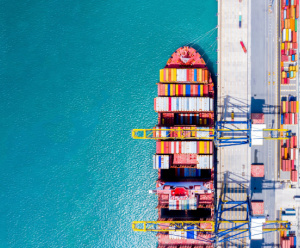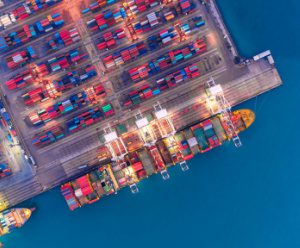
Ocean freight rate moving towards manageable levels

A muted peak shipping season in 2022 has prompted a downward shift for freight rate levels as effective vessel supply increases and demand into some key import markets slows.
Container lines have responded – albeit, far too slowly, according to most shipping analysts – by blanking sailings for Golden Week in early October. More blank sailings and service suspensions are now expected.
Even so, with the orderbook set to deliver huge amounts of new box capacity next year, many are now wondering where the floor is for container shipping. Indeed, reports suggest that carriers are aggressively seeking cargo and preparing to lay ships up.
“This year, we did not see the normal rush for space ahead of Golden Week when factories close in China,” said Kelvin Leung, CEO, DHL Global Forwarding Asia Pacific.
DHL’s monthly Ocean Freight Market Update noted that the capacity demand and supply balance is much improved, although the blanked sailings by carriers in early October could be a sign of more service cuts to come.
“We’ve seen an easing of port congestion, although labor strikes at ports in the U.K. are causing some disruption and we’re still seeing vessel queues on the U.S. east coast which has offset improvements at U.S. west coast ports,” added Leung.
Logistics bottlenecks also remain in Asia. The Chinese government’s dynamic zero Covid-19 policy has impacted major manufacturing and exporting centers like Chengdu, Dalian, Guangzhou, Shenzhen and Tianjin. Whilst port operations are exempt from restrictions, manufacturing and inland logistics have been affected to varying degrees.
Container line dilemmas
After container lines racked up profits of USD 400 billion from Q2 2020 to Q2 2022, shipping analyst firm Drewry expects the period of ‘managed decline’ now underway to determine how much of those super-cycle returns carriers will keep.
“Lines face an enormous challenge taming the one thing they have control over – supply,” reported Drewry. “The problem is - there is a lot of it, and they are being attacked on multiple fronts.”
One of those fronts is that latent capacity “lost” due to supply chain/port congestion is now returning to the market as bottlenecks ease. “As congestion fades, capacity will increase inversely and for 2023 we see bottlenecks on their own only stripping around 7 percent of effective capacity from the market,” noted Drewry.
According to maritime analysis firm Sea-Intelligence, 50 percent of the global port congestion that was tying up vessels at ports in January had been cleared by August. The release of this extra capacity has relieved physical shortages of capacity and added to downward pressure on spot freight rates which have been in decline on the major East-West trades since the second quarter.
Another factor weighing heavily on the supply side of the container shipping market is vessel ordering over the last two years. This has pushed the global orderbook-to-fleet ratio to just under 30 percent by late September, up from a low of around 9 percent some two years prior, according to Alphaliner. Record deliveries are due in 2023 and 2024 when analysts expect vessel supply to outstrip demand.
Demand outlook
The demand side outlook continues to weaken on war risk, skyrocketing energy costs, political instability and general inflation, all of which are now impacting overall consumer spending and thus trade volumes.
The S&P Global Eurozone Manufacturing PMI fell to 48.4 in September, from 49.6 in August, signaling a further worsening of operating conditions for euro area goods producers.
Chris Williamson, Chief Business Economist at S&P Global Market Intelligence said the “ugly combination” of a manufacturing sector in recession and rising inflationary pressures would add further to concerns about the outlook for the eurozone economy.
“Excluding the initial pandemic lockdowns, eurozone manufacturers have not seen a collapse of demand and production on this scale since the height of the global financial crisis in early 2009,” he added.
While the economic picture is far brighter in the U.S. than in Europe, the import boom is now slowing. “The growth in U.S. import volume has run out of steam, especially for cargo from Asia,” said Ben Hackett, founder of Hackett Associates.
“Recent cuts in carriers’ shipping capacity reflect falling demand for merchandise from well-stocked retailers even as consumers continue to spend.
“Meanwhile, the closure of factories during China’s October Golden Week holiday along with the Chinese government’s continuing zero Covid-19 policy have impacted production, reducing demand for shipping capacity from that side of the Pacific as well.”
Drewry has now lowered its global container handling demand outlook for 2022 and 2023 to 1.5 percent, and to 1.9 percent, respectively, on the back of heavily downgraded GDP predictions.
Carrier action
Drewry points out that current spot freight rates remain highly profitable for carriers despite months of declines. Even so, the analyst firm does not expect container lines to sit idly as rates slide. It predicts ship deliveries will be pushed back, unprofitable ships will be offloaded or scrapped, and multiple services will be suspended.
“Assuming carriers do exactly as we expect, those combined actions will still be insufficient to fully bridge the supply-demand gap next year, with an estimated net increase in effective capacity of 11.3 percent way above the projected demand growth of 1.9 percent,” reported Drewry. “Adding in missed sailings will, however, get them closer and should be enough to keep freight rates and profits above 2019 levels.”
In the meantime, the more favorable supply-demand balance for shipping’s customers is also finally prompting improvements in service reliability. Global schedule reliability improved by 5.8 percentage points in August compared to July while the average delay for late vessel arrivals also dropped sharply, according to Sea-Intelligence.
“Global supply chains still face a lot of disruption, but we’re seeing service levels from carriers improve as congestion eases and more capacity is freed up, and we expect this trend to continue. However, the balance between supply and demand will be the key to rates stability in the months to come and we are monitoring this development very carefully,” said Dominique von Orelli, Global Head, Ocean Freight, DHL Global Forwarding.








 English
English